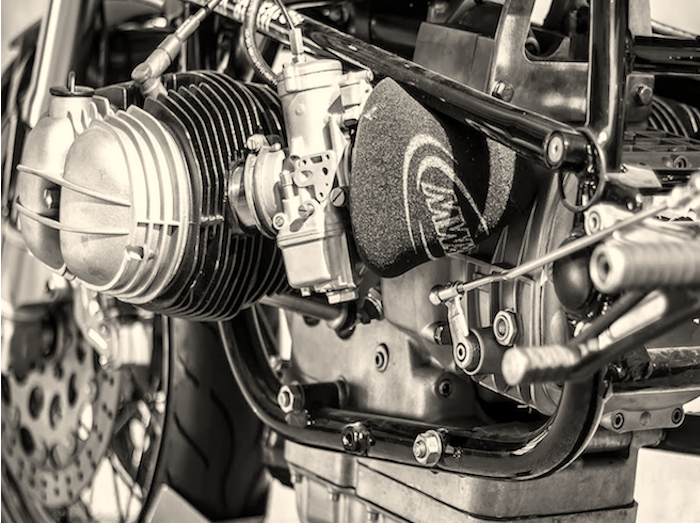The principle of carburetor balancing.
On a multi-cylinder engine with several carburetors, it's essential that the carburetors are synchronized so as to feed all the cylinders equally.
The principle is to equalize the pressure (or rather vacuum) within each carburetor, at idle and at all engine speeds, by acting on the synchronization screws. (See article "Why balance carburetors")
TwinMax, the easiest balancer to use.
Twinmax weighs just 200g and fits comfortably in the hand. It requires no complicated set-up and no special tools. Just switch it on and it's ready to go. It comes with all the accessories needed for balancing virtually any motor.
The TwinMax philosophy.
The Twinmax is an electronic device that uses a 2-input air pressure sensor.
An electronic module receives the pressure measurements and interprets them according to the desired sensitivity. A display precisely indicates the pressure difference between the 2 air inlets.
Simply connect the 2 air inlets to the carburettor or injection system intake pipes, and you'll see the pressure difference that can exist at any engine speed.
Synchronization is the last of the settings to be made.
Carburetor synchronization is the last adjustment to be made on an engine, and carburetor adjustment is the last adjustment to be made on an engine.
Consequences: first check the entire ignition system (spark plugs, switches...), then the air supply system (air filter, air box...) and finally the fuel supply system (filter, richness, idle...).
The method.
Perfect synchronization of the injection system and carburetors is achieved in 2 steps:
Step 1: Set the idle timing
-
Unscrew the vacuum screws located under the carburetors and connect the two Twinmax tubes to the inlets.
-
Switch on the Twinmax by pressing the red button, turn the "sensitivity" knob towards maximum and use the "Zero" button to bring the needle to the center of the dial.
-
Start the engine and bring the Twinmax sensitivity to 3/4 of maximum, which will be sufficient for good settings.
-
With idle speed stable, the needle should move more or less to the right or left. If not, increase Twinmax sensitivity.
-
Choose your first carburetor and set the idle speed to the level recommended by the manufacturer. The needle may then deviate even more sharply.
-
Synchronize the second carburetor by turning the idle screw to bring the Twinmax needle back to 0.
-
Switch off the ignition and, if you don't plan to carry out dynamic synchronization afterwards, tighten the carburettor vacuum screws.
Step 2: Set dynamic synchronization
-
Having synchronized at idle, the Twinmax needle should not deviate to the right or left.
-
Increase engine speed to 1500 to 3000 rpm to energize the throttle cables. The Twinmax needle will then deviate if there is a synchronization fault.
-
Adjust the spool lift or throttle opening system until the Twinmax needle is perfectly aligned with "0". Dynamic synchronization is now complete
-
Switch off the ignition and tighten the carburettor vacuum screws.
Where can I find the synchronization sockets?
On the latest carburetors, the synchronizing plugs are always present and easy to locate. If in doubt, consult your vehicle manual.
On older carburetors, it may be necessary to screw adapters onto the threads provided (usually M5 or M6).
Very rarely, there are no synchronizing sockets. In this case, the intake pipe must be drilled and threaded to match the adapter thread (M5 or M6).
The case of carburetor manifolds.
A carburetor manifold generally consists of a reference carburetor. This is the one without the synchronizing screw. All you have to do is balance each carburetor against the reference carburetor.
By default, you should identify the carburetor with the lowest vacuum: this will serve as the reference carburetor. Then simply balance each carburetor with the reference carburetor.

